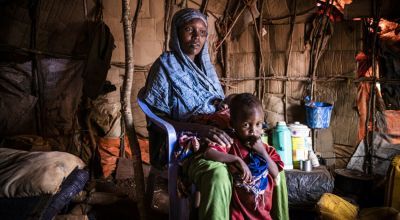
Read our 2023 annual report

Knowledge Hub
A famine is expected to be declared in Somalia in the coming weeks. It will make headline news, but news reports will fail to capture the horror that famine entails.
This time 30 years ago I was a reporter for the then-Cork Examiner. I was sent to Somalia to report on the famine in which up to 300,000 people died. My memories of three visits to the war-torn, drought-stricken country are the stuff of nightmares. And now, 30 years later, famine is back.
A famine is something that nobody should witness, let alone live through. It should be something that is consigned to history, but it isn’t. Now with famine looming again, we should remember what happened in the past and act urgently to prevent further suffering and death.
Somalia in 1992 was lawless, violent and ruled by war lords and armed gangs. “Technical vehicles” — jeeps and vans with belt fed machine guns fixed to the roof or back — patrolled the streets of Mogadishu. Anyone who wanted a gun had one. Inter-gang disputes resulted in shoot outs, people were robbed at armed check points on roads. A doctor at one local hospital told me they dealt with 35 gunshot wounds a day.

But it wasn’t the danger and the violence that stayed with me. Instead, it was the silence of a screening centre in Baidoa filled with mothers and sick infants — too ill to even cry. Rows and rows of women with their babies, sitting on the floor, waiting to be seen by the nurses, glad they had got this far, but worried about the condition of their children. Huge rooms of listless children, their eyes rolling in their heads, their mothers stroking their cheeks to comfort them. The only sound was the occasional weak whimper.
Yet these were the lucky ones. Many families did not make it this far. The dusty roads to the major towns where feeding centres and clinics were located were littered with the bodies of dead livestock and occasional bundles of rags — people who had died on their way to get help. Often there were three or four bodies huddled together.
Humanitarian organisations providing food and health care were unable to meet the huge needs in towns and cities. I remember the huge queues outside schools or other buildings which had been transformed into feeding centres. Given the limited capacity of centres and finite resources, nurses were tasked with the unenviable job of screening the huge crowds of people outside each morning and only being able to admit the most sick.
And even for some people it was too late. One nurse told me that regularly she worked with children that she realised were too sick to save. “You have to prioritise your human resources when you are here. You provide the best standard of care to the greatest number of people. But you have to realise when somebody is going to die and accept it,” she said. She would deal with the personal trauma of this when she returned to Ireland, she added.
One nurse told me that regularly she worked with children that she realised were too sick to save
The hardest cases to deal with were the small children and orphans. Nurses pointed to children who had been found in huts alongside the bodies of their dead parents and siblings. Older children had buried their last remaining relatives before walking into the local town for help.
My other lasting memory of the famine of 1992 was the ‘death cart’ as it did its daily rounds in Baidoa. Pulled by a donkey, it was used to collect the bodies of those who had died overnight. The proper burial of bodies was essential to stop the spread of diseases in the crowded temporary camps which had sprung up in the town.
Local gravediggers had stopped digging individual plots and switched to digging trenches for mass burials. In one camp of 8,000 people, they were burying 60 people each day.
I remember meeting a man call Adeu as he carried his dead three-year-old son in his arms towards a burial area. His shoulders back, walking upright, his eyes fixed firmly ahead of him — determined to give his son a decent burial. This was the fifth time in as many months that he had made this journey, having previously lost his wife and three of his children.
Death was everywhere in Baidoa at the time. Funerals like this were so commonplace that two women passed by without even turning their heads.
Today, Baidoa is at the epicentre of the current drought and impending famine. What was once a town is now a city of one million people — some 700,000 of those living in huge displacement camps which have sprung up around it. An estimated one thousand people a week are still arriving in from the surrounding countryside in search of food and water.

Organisations like Concern have been working with communities in Somalia since 1992 and much has changed and improved over the years. Previously, two failed rains would have tipped communities into a crisis. But communities have become more resilient.
However, Somalia and neighbouring countries are currently experiencing their fifth failed rainy season, with predictions that the next rains, due in March, will also be below average. Nobody can survive more than two years without proper rain. And so famine is again at the door.
And, just like in 1992, humanitarian organisations are on the ground, doing their best with the limited resources available to meet the huge needs which are growing by the day. An earlier and greater response by the international community would have saved thousands of lives in 1992. An urgent and major response by international donors is needed today, if thousands of lives are to be protected and untold suffering averted.
Eamon Timmins is Media Relations Manager for Concern Worldwide.






